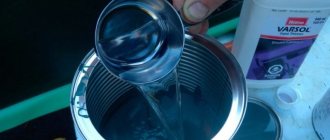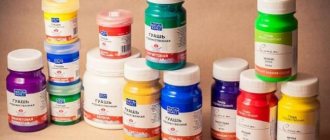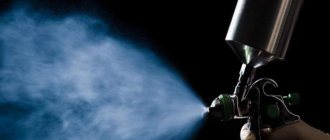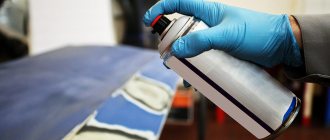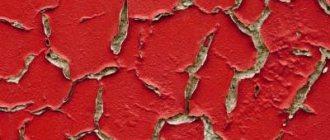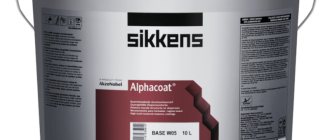Types of thinners
Water
Water is the most common diluent and is also very accessible. Water must be used filtered or distilled. Paint diluted with water becomes very fluid and there is a high probability of smudges on a hard surface. It loses its saturation and its hiding power weakens. Water takes a long time to evaporate from the surface.
Isopropyl alcohol (isopropanol)
Isopropyl alcohol is commercially available in various proportions with water. Pure isopropanol evaporates very quickly and for dilution you need to use a mixture of it with water. With this thinner, the paint saturation and hiding power are very good. The colors come out bright. This is because isopropyl alcohol evaporates quickly, leaving pigments behind. Isopropanol is very liquid, like water. Paint diluted with isopropanol is sprayed and lies on the surface smoothly, without a “drip” effect. Again, I repeat that isopropyl alcohol evaporates very quickly and requires dilution with water (50-65% alcohol, the rest water), otherwise the paint will dry quickly right in the airbrush as soon as you stop spraying.
Retarders/retarders
These additives slow down the drying time of paints, improve their fluidity and mixability. This additive can be added additionally along with paint thinner. Adding a retarder helps prevent the needle tip from clogging up quickly (as the paint dries more slowly). This product can also be mixed into undiluted paint so that it does not dry out longer during storage.
Mediums
These are additives that change the properties of acrylic paints. Retarders (retarders) also belong to paint media. By adding different mediums you can achieve different effects. They change the consistency, slow down drying, add a transparent effect, and make the paint matte or glossy.
Many airbrush artists prefer to prepare thinner using their own recipe. They mix different thinners and additives and thereby give the paint different properties. In a separate article I will tell you how to make your own optimal acrylic thinner.
What to do if acrylic paint has dried out?
It happens that due to improper storage at home, even in a short time, the composition manages to thicken or dry out greatly. To correct this situation, you must do the following:
- The acrylic mixture differs from simple enamels in that it can be diluted at different degrees of drying of the base composition. So, when the viscosity increases, water is simply added to the solution and mixed well. The main thing is to close the container tightly. This rule also applies to cases where there is a small residue after painting.
- If clots are observed in the composition, then add a little alcohol to the water. The mixture is thoroughly mixed until the lumps completely disappear. A small amount of solvent is poured on top and the container is well sealed.
It is more difficult to restore a dried composition. To do this, a whole set of actions is performed:
- The hardened material is removed from the container and broken into small pieces. It is important to prevent the entry of dirt and dust.
- Lumps must be crushed as much as possible. To do this, you can use a piece of pipe or fittings of suitable diameter.
- The resulting powder is poured into a convenient container and filled with well-heated water. The solution is not stirred, but shaken several times. After a minute, the liquid is drained.
- A new portion of hot liquid is added and the procedure is repeated.
- A special diluent is poured in and the mixture is stirred well until the desired viscosity is obtained. But such a material will no longer have all the properties.
If the paint has dried to a stone state, then it is better not to restore it. Although you can follow the previous procedure, which will require effort and time, the resulting composition is best used for utility rooms.
Table of contents:
Acrylic paints appeared about 50 years ago and have not lost popularity to this day. They are suitable for interior decoration, intended for painting wooden and metal surfaces, plastered walls and ceilings.
Depending on the texture of the surface and the purposes pursued, this material must be diluted. This can be done in different ways, and we will look at everything in detail.
Mixing the coloring composition
You need to know how to dilute acrylic paint for the ceiling, since the final result depends on the correct preparation. The fact is that a thick coloring composition is not able to hide the junction of paint strips. The paint should be diluted with water until the consistency recommended by the manufacturer is obtained. Mix them together with a mixer.
When the instructions indicate adding water to the paint, its volume is usually no more than 5-10%. In some cases, it is not necessary to dilute the coloring composition, then the instructions simply indicate the need to mix it, but this should be done carefully.
If you plan to apply paint in one layer, then good mixing will be enough. The best option is considered to be diluting it to the consistency of milk. If there is a film on the surface, there is no need to mix it with the paint, since it does not dissolve after drying.
As a result of this action, the resulting composition ends up with lumps. Experts advise carefully removing the film, straining all the remaining substance and only then stirring. In addition, you can add antifungal components to the paint, which are highly resistant to wet cleaning.
How to dilute acrylic paint?
Acrylic composition is a type of modern water-based (water-dispersed) paints. Due to its many positive properties (environmentally friendly, reliable, quick drying), this solution is perfect for painting indoor and outdoor surfaces. Acrylic mixtures are also actively used for decoration and painting; there are special options for various materials.
In terms of consistency, a water-based acrylic solution is most often a rather thick mixture that needs to be diluted. To choose the optimal diluent, you need to pay attention to the composition. The main component that gives this group of paints its name is water; the base can make up up to 50–60% of the solution.
Thus, the solvent is water, which must meet certain requirements to obtain an ideal result:
- Temperature. To dilute the mixture, the liquid must be within 20 degrees. If façade paint is used, it is 4–5 degrees higher than the street level (minimum 15–18 o C).
- No impurities. It is recommended to use distilled water, which does not contain foreign substances. If such a composition cannot be obtained, then the liquid is first brought to a boil and settled.
Features of diluting acrylic with water
To properly dilute acrylic paints, you need to know the proportions that allow you to achieve different results:
- Ratio 1:2. If there are two parts of water to one part of the coloring mixture, then such a solution turns out to be quite liquid. It adheres well to the brush, but leaves streaks behind, so it is better to apply it with a fleecy roller. The mixture is suitable for creating a base for a base coat.
- Proportion 1:1. This composition is used to obtain the base layer. It has good viscosity and fits perfectly onto the surface. After it, a composition similar in consistency can be applied, but it is better to dilute the final layer minimally.
- A less common option is when the paint needs to be dissolved in five parts of water. This method is used by professional designers or artists when they need to tint textured elements. The composition is quickly absorbed, and the layer is barely noticeable.
What else is used to dilute paint?
Although water is the optimal solvent that is available to everyone, there are special liquids - thinners. According to their structure, they are divided into several varieties:
- Universal. Suitable for all standard compositions used to decorate walls, ceilings and facades.
Each option is used according to the recommendations provided by the manufacturer. Experimental breeding is often necessary to achieve individual results.
Diluting acrylic paints with water
The basis of acrylic paints and varnishes is water, so it is advisable to use it to achieve the required consistency. An important point: you need to use only clean and cold water, standing for several hours or distilled, to prevent interaction between the components of the paint and varnish material and the thinner.
- dilution with water 1:1 - the material can be used to create a base layer, the paintwork lays down smoothly, without smudges or sagging, forming a uniform coating that effectively protects the surface from corrosion and aggressive environmental influences;
— 1:2 – the consistency is more liquid, allowing you to create a thin and even layer, the paintwork material saturates the brush or roller well;
– 1:5 – creates “colored water”, which is used to color textured details; the composition is well absorbed and fills depressions and other depressions on the surface;
— 1:15 – the proportion is not used often, it is intended to create a transition between tones (gradient); in fact, it is no longer paint, but colored water.
After applying acrylic water-based paint and varnish material, you must immediately thoroughly clean the tool used. This is explained by the fact that after drying, water-based acrylic paintwork becomes water-resistant. And, accordingly, rollers, brushes and other painting tools, once dry, cannot be cleaned.
Dilution with special acrylic thinners
Dilution with water or water with alcohol is only permissible when using a roller or brush. Paint sprayers and spray guns (painting equipment) require the use of acrylic thinners, the brand of which must be indicated by the manufacturer on the packaging. They have a specific smell and transparent appearance. The required amount of addition of such liquid depends on the scope of application, temperature and humidity of the external environment. Depending on the composition, acrylic solvents create a matte or glossy layer on the surface. Different coloring effects are achieved using a certain proportion, which is usually indicated on the thinner packaging.
Advantages of using acrylic solvent:
— accelerated drying time;
— the ability to create a matte or glossy surface;
— formation of an even layer without smudges and white deposits;
— chemical purity, compared to water;
— increased stability of paint characteristics.
What to do if the paint has dried
It is impossible to accurately calculate the amount of material needed, so professional builders prefer to take it in reserve. After interior finishing, there are situations when some amount of paint remains unused.
The remainder in the jar gradually dries out - the moisture evaporates over time, and polymerization begins. The more liquid “leaves”, the lower the performance characteristics of the composition.
You shouldn’t immediately throw away the damaged material: you can try to revive the paint, returning it to its original properties.
Instructions for restoring dried paint.
Grind the remains into powder with a minimum fraction.
Pour boiling water over for 2-3 seconds , then drain.
Repeat the procedure 2-3 times so that the composition warms up.
Leave the boiling water in the jar and mix the contents thoroughly until smooth.
If the paint has turned into a homogeneous plastic lump, proceed as in the previous case. But at the final stage of resuscitation, add alcohol instead of hot water. Regular women's nail polish, added a little at a time, can also help.
If finances allow, buy acrylic thinner "Gamma" . It is inexpensive, but does an excellent job with paint that has acquired a “rubber” consistency. The product is sold in online stores and specialized retail outlets.
The performance properties of the restored material will be lower than the original ones - the lumps will not completely dissolve, which will negatively affect the strength of the coating. Use this composition for painting minor surfaces that are not noticeable.
If acrylic paint has deteriorated after improper storage, for example, at subzero temperatures, it cannot be restored. In such a situation, irreversible polymerization of the material begins, various substances will be powerless.
How to dilute with water
In its original form, acrylic paint has a thick consistency, so it needs to be diluted. For this, special solvents or products recommended by the manufacturer are used.
However, you can use a simple and affordable means for dilution - water. This component is initially included in the composition, so it does not disturb the texture and makes the consistency convenient for application.
It is important to understand that the proportion of water must be strictly observed so as not to spoil the original properties. In addition, for the intended purposes you will only need clean and cool water, without additional impurities.
In painting work, four types of dilution proportions are used:
Ratio 1:1. If you add water in equal quantities to the volume of paint, you will get a consistency suitable for applying a base coat. The liquid will be thick, but will not stick to the roller or brush and will lie evenly over the surface.
Ratio 1:2. If you add two parts of water to one part of paint, you get a composition of a mobile consistency, creating a thin layer on the surface to be painted. Used on smooth surfaces to reduce the intensity of dark colors.
Ratio 1:5. If the amount of water added 5 times the volume of paint, a liquid composition is obtained - tinted water, which will penetrate between the fibers of the working tool. When applied, a barely noticeable layer is formed, which will look interesting when painting textured surfaces.
Ratio 1:15. In this case, the result is ordinary water with a small amount of dissolved dye. This composition is used to create smooth transitions between shades and gradient color designs.
How to revive dried paint?
It often happens that the acrylic left after painting dries out. The water evaporates and the paint loses its quality characteristics. The irreversibility of the process leads to the fact that only through dilution can the paint be revived. Just remember that it will not acquire its previous properties.
If the acrylic paint is very dry, grind it into powder with a sharp object and then pour boiling water over it. After a few seconds it is drained and the manipulation is repeated. After sufficient heating, the paint can be stirred. True, it will no longer have a uniform structure, but it can be painted.
Some craftsmen manage to resurrect paint that has turned into a tight clot. To do this, carry out the same procedures by adding alcohol to the water. Of course, in this case there is no point in talking about good coverage.
General information
Next, we will look at the most popular of them, because the result and quality of your work will depend on the correct choice of solvent for acrylic paints.
Difference between thinner and solvent
Despite the fact that the words are very similar in meaning, incorrect use of these components can ruin not only the paint, but also the finished result. To avoid having to run to the store for a new can of paint, you should remember these differences.
The thinner does not particularly affect the quality of the product itself, but it changes the color saturation and also changes the thickness
It is important to remember that when using a thinner, the paint dries faster, and therefore you have to work with it in an accelerated mode
The solvent is useful when the task is to wash off paint from a surface or remove a dried layer. At the same time, acrylic becomes more liquid, and accordingly, the drying time increases significantly.
Types of solvents for acrylic paints
Acrylic is never used in its pure form for painting or finishing work. Due to rapid drying, there is a high probability of obtaining an uneven surface with marks from a brush or sponge. For the same reason, it is recommended to wash the tools used, especially brushes and rollers, immediately after finishing work. Otherwise, after the paint has dried, it will be easier to purchase new brushes than to clean the old ones.
How to dilute with solvents
In 90% of cases, solvents are colorless, with a distinct specific odor. These products are used to change the texture of acrylic paints and obtain a matte or glossy surface. Unlike water, which can add “cloudiness” to the color, special thinners do not have such a negative effect.
The proportions of adding such funds depend on the type of proposed work. If there is a lot of solvent, the texture will become translucent; if there is little solvent, the thick, rich color will remain. Manufacturers give recommendations for dilution, follow them.
The use of solvents depends on the air temperature.
When painting in cold weather, use solvents with a high drying speed to ensure the paint has good adhesion to the surface.
At normal temperatures, use compounds with an average drying speed. They are considered universal and suitable for all types of work.
Slow drying solvents are designed for hot weather and prevent water from evaporating too quickly.
It is important to understand that a properly selected solvent improves the performance characteristics of the composition, affects the strength of the coating and color saturation.
Solvents that are compatible with acrylic paints:
gasoline and white spirit - compositions with a high drying rate;
kerosene – average volatility value;
turpentine - slow evaporation.
There are positive reviews about RELOCRYL ACRYL , which is designed specifically for diluting acrylic paints, varnishes and primers.
If the composition gets on a surface not intended for painting, it is washed off using a solvent remover. The composition is available in the form of a paste. It is applied to the desired area and left for 10-15 minutes . The remover dissolves the acrylic and excess is easily removed.
Regardless of the chosen option, it is important that two rules are followed - the resulting solution should not coagulate, and the presence of lumps is unacceptable.
